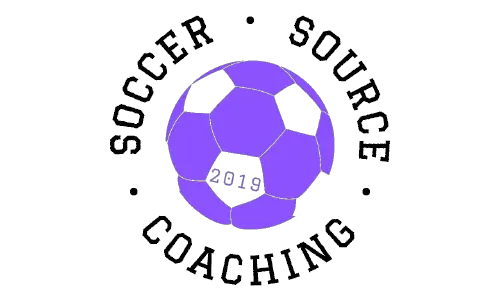In soccer, you have to adapt to get the match results that you want. Having a plan B up your sleeve is always a good habit to get into. One of the most common ways for a coach to adapt their team is to change the formation. There are a number of reasons that a coach may want to change their formation depending on the tactics, players, and score of the game. This post will go over the 4-1-4-1 soccer formation and help you decide whether it will be a good fit for your team!
What is the 4-1-4-1 soccer formation? (Positions and numbers)
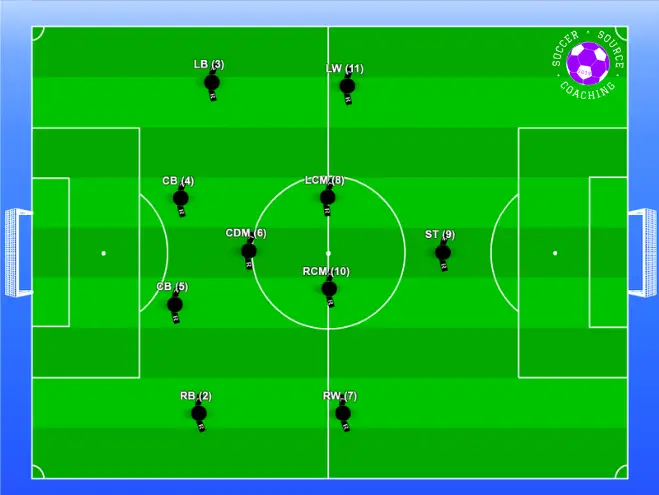
The 4-1-4-1 is made up of 4 player lines, the defensive line, 2 midfield lines, and a forward line.
Obviously, the formation has a goalkeeper too!
The defensive line comprises a left-back, a right-back, and 2 center backs.
There are midfield lines in this formation, the first line is made up of a central defensive midfielder, with the second line made up of 2 central midfielders, a left winger, and a right winger.
Finally, the attacking line is made up of 1 striker.
4-1-4-1 Soccer tactics explained
The 4-1-4-1 soccer formation is a more defense-focused formation.
The goal of this formation is to be as hard to break down as possible.
With the defensive midfielder playing just in front of the back line and sitting behind the middle line, it makes it very hard for opposition attackers to find space in central areas of the pitch.
This is a great soccer formation for a team that is playing against a stronger opposition, who likes to control the game with possession, or a team that is looking to protect a lead and see out the game.
Attacking tactics of a 4-1-4-1 soccer formation (in possession of the ball)
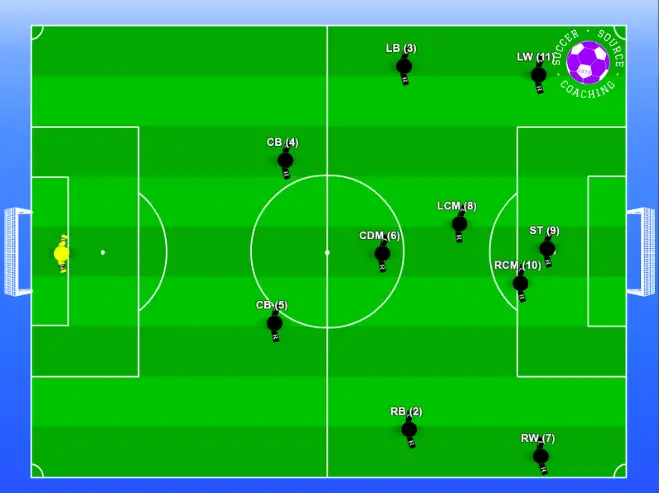
When attacking in a 4-1-4-1 soccer formation the striker plays a critical role in how successful the attacks are.
The striker is to act as a target player and holds the ball up for their teammates to come up and support the attack.
When the striker gets the ball the winger should move up in the wide areas, to give them an option outside, with one of the central midfielders dropping off to allow the striker to pass back to them and the other looking to make a run in behind.
The fullbacks should push as well and look to make underlapping or overlapping runs to help support the wingers.
Even if the fullbacks do not receive the ball their run would have still created space and time for the winger.
While the team is attacking the defensive midfield will act as a pivot player, moving the ball from congested areas of the pitch to areas where there is more space.
They will also be a great option for players to pass back to if they cannot go forward
Defending tactics of a 4-1-4-1 soccer formation (out of possession of the ball)
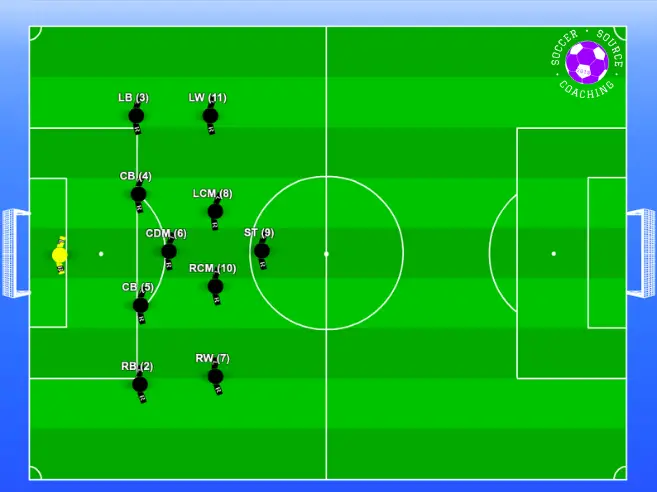
While defending in the 4-1-4-1, the players will become compact and stay in their 4 distinct player lines.
The striker will close down passing lanes, and force opposition players to try and play to the wide areas, where there are fewer forward options on the ball for the opposition.
The central midfielders will also step up and press if the opposition player with the ball is closest to them.
When the ball has been passed off the central midfielder will drop back into their player line to prevent any gaps from appearing.
A big reason why this formation is such a hard position to break down is because of the central defensive midfielder.
By sitting in the gaps between the defensive and midfield line they are occupying a space that opposition attackers love to move into to receive the ball.
The defense has the responsibility of making the whole team step up when the opposition team has played the ball backward or shuffling over when the ball has been played to the side.
4-1-4-1 soccer formation advantages and disadvantages
Like all formations, there are strengths and weaknesses.
This will highlight the advantages and disadvantages of the 4-1-4-1 soccer formations
4-1-4-1 soccer formation advantages
Hard to break down
As this is a defensive-focused formation, naturally it can be very hard to break down!
The formation is compact and crowds out the central areas where the opposition’s play-makers want to find space.
This will limit the amount of space and time the playmakers will have on the ball.
The less time on the ball, the less of an impact they will have on the game
Easy to understand player roles
The positions and structure of the formation make it really easy for the players to understand.
There are distinct roles and areas of the pitch a player should be in.
This means it is perfect for new soccer players to 11v11 looking to learn the basics
Great for playing out the back
As well as playing a defensive role in the team the defensive midfielder plays an important role in helping your team play out from the back.
When your team splits to make the pitch as wide as possible more space is created for players in the central areas.
This will mean that your defensive midfielder will be able to move into a great spot to receive the ball to feet and help your team progress up the field.
4-1-4-1 soccer formation disadvantages
Fewer attacking options
When the primary focus of the formation is to defend, you will take away from the attacking power that your team has.
As the 4-1-4-1 formation only plays with 1 striker this will often leave your forward outnumbered.
This will also make your passing patterns and style of play a lot more predictable and easier to defend against.
The striker may also become frustrated and disinterested and look to drop deeper to receive the ball, however, this will take away the depth from the team and close the space in central areas when attacking.
Ridgid formation
Although the formation is great for beginners because of the simplistic style, this can hinder a team when they need to attack.
The formation is not as fluid when going forward and the team may lack creativity when getting to the final third.
There is also no player playing the number 10 role on the pitch.
This is the player on the pitch who will look to link the midfield to the attack and create dangerous goal-scoring opportunities.
Less time spent in possession of the ball
If you are setting up in defensive formation, to begin with, it usually means that you are looking to not lose the game against a stronger opponent.
This means that your team is going to have to be comfortable going long periods of the game without possession of the ball.
When you have less of the ball, you create fewer chances.
Player responsibilities in a 4-1-4-1 soccer formation
No matter the formation, the success of it will rely on how well the players fulfill their roles and responsibilities in their position.
The roles and responsibilities of the players in the 4-1-4-1 will change depending on whether the team has possession of the ball or is not in possession of the ball.
Center back responsibilities in a 4-1-4-1
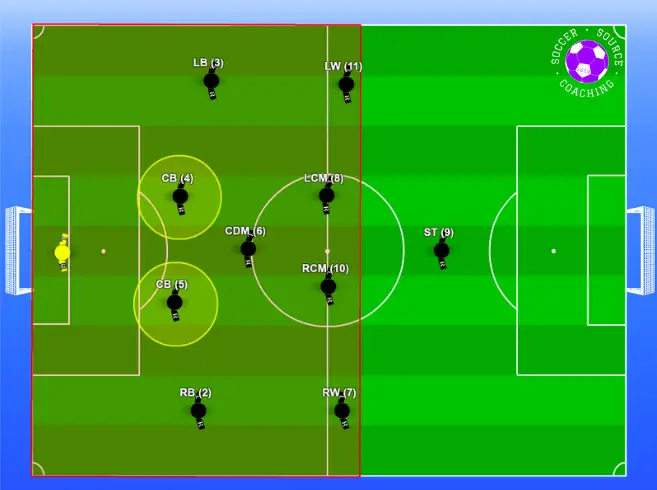
The center backs are the players who play at the heart of the defense.
In the 4-1-4-1 soccer formation, their main role is to prevent the other team from getting into goal-scoring opportunities.
Defending makes up the majority of the center-back responsibilities in the team, however with how the game of soccer is evolving center backs are having to become more comfortable with the ball at their feet than ever.
Here is a complete guide on how to be a center-back in soccer
Center back roles and responsibilities when attacking
When the team has possession of the ball in their own half the center-backs should look to split and drop off.
This helps them to:
- Create better angles to receive the ball
- Allows the central players to have more space in the middle
- Give them more time and space on the ball to make better decisions.
When the team has possession of the ball in the opponent’s half the center-backs can help support the attack by:
- Positioning themselves on the halfway line or just in front of it
- Becoming an option to play back to if a pass cannot go forward
- Play passes that break through opposition defensive lines.
For a center-back to successfully fulfill these roles then they must be comfortable passing and receiving the ball on both feet.
Center back roles and responsibilities when defending
Defending is the main bulk of the center-backs responsibly in the 4-1-4-1 soccer formation.
In this formation, the team will be mostly using a midfield press or a low block to defend against the opposition.
When in a press it is the center-backs responsibility to:
- Communicate with teammates so they are aware of what is going on around them
- Hold the line and step the team up when the opposition plays a pass backward
- Win aerial duels in case a team decides to play a long ball.
The center-backs should be constantly scanning around them and anticipating what is going to happen next to help break up the play.
Fullback responsibilities in a 4-1-4-1
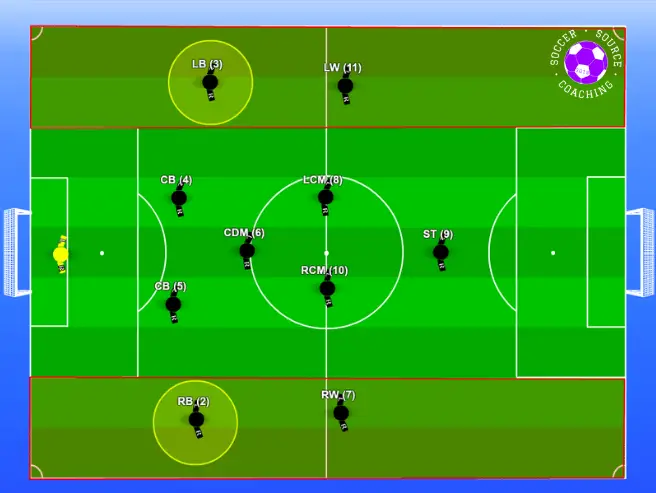
The fullbacks will play on the outsides of the center-backs and it is their responsibility to prevent dangerous attacks coming in from the wide areas.
While in possession of the ball, the fullbacks will support the attack and combine passes with their respective winger to create goal-scoring opportunities from wide areas.
This a complete guide on how to be a fullback in soccer
Fullback roles and responsibilities when attacking
When in possession of the ball in their own half, a full-back must provide a team with a wide option by standing as close to the sideline as possible.
This will really help the possessing team in the 4-1-4-1 formation play out from the back.
When the fullback receives the ball they should be looking to play the ball forward, either down the line to the winger or central into one of the center midfielders.
While in possession of the ball in the opposition’s half, the fullback should be looking to get forward and provide support to the winger as frequently as possible.
They can do this by making underlapping runs, overlapping runs, or third-man runs.
If the fullback receives the ball in wide positions, they should look to cross the ball into the box for a teammate to get on the end of.
Fullback roles and responsibilities when defending
The fullback will be responsible for marking the opposition’s winger.
While defending against the winger it is essential that they follow these defending tactics:
- Quickly close down the space the winger has
- Stand the winger up and show them away from the goal
- Wait for the winger to make a mistake before stepping in to win the ball
While defending the fullback must remain closer to the center-backs, this will make the gaps smaller for the opposition to play passes that break the defensive lines.
The fullback must also communicate with their winger to ensure they are tracking back and marking their player.
Defensive midfielders’ responsibilities in a 4-1-4-1
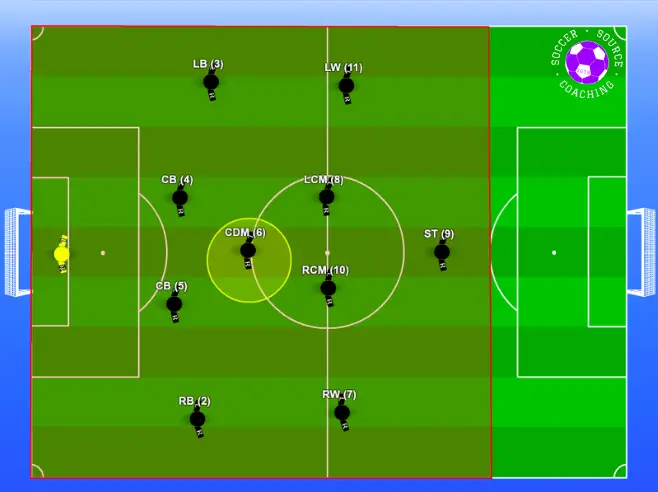
In the 4-1-4-1 soccer formation, the defensive midfielder is a player who sits between the midfield line and the defensive line.
Their role is predominantly to screen the back 4 to ensure that play is broken down before it even gets to the defenders.
Once they have won the ball the defensive midfielder will look to play forward and keep possession of the ball.
Here is a full guide on how to play as a defensive midfielder in soccer
Defensive midfielder roles and responsibilities when attacking
When the team in the 4-1-4-1 soccer formation has the ball in their own half the defensive midfielder should be looking to find space in the central areas of the pitch to receive the ball.
They should be playing on the half turn, ready to turn and play forward if they have the opportunity.
However, this cannot play forward they must look to play either sideways or backward.
When the team is attacking the opposition half the defensive midfielder has the role of being the team’s pivot.
This means they will help change the point of attack and recycle the ball when their teammates cannot go forward.
To do this the defensive midfielder must have a good passing range, being able to make short passes as well as longer passes.
Defensive midfielder roles and responsibilities when defending
When defending the defensive midfielder must hold the space just in front of the defensive line.
This will prevent the opposition from attacking and receiving the ball in dangerous attacking spaces.
The defensive midfielder will also be in a good position to cover for the central midfielders if an attacking opposition gets past them too.
They must also be responsible for marking late runners coming into the box from opposition crosses.
Central midfielders’ responsibilities in a 4-1-4-1
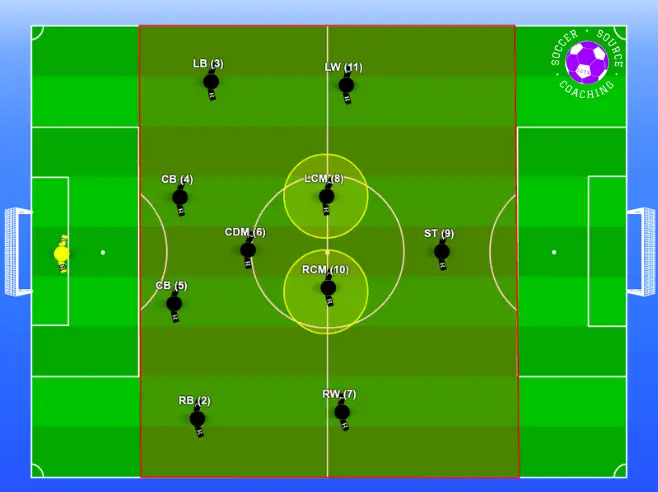
The central midfielders in a 4-1-4-1 soccer formation play as the 2 middle players in the midfield line.
These will typically be box-to-box center midfielders as they will be fulfilling their defensive responsibilities but also getting up the pitch and supporting the attack too.
For players to be successful in this position they need to have an incredibly high work ethic, combined with a great reading of the game and an eye for attacking.
Center midfielder roles and responsibilities when attacking
When the team has possession of the ball in their own half the center midfielders should look to create angles and check into the space in the middle of the pitch to receive the ball.
However, they must be wary of encroaching into the defensive midfielders’ space.
Once they receive the ball they should be looking to:
- Break the first defensive line of defenders (through either dribbling or passing)
- Keep possession of the ball if they cannot go forward
- Move as soon as they have played a pass to support the next phase of play.
When the team is attacking the opposition’s half, the responsibility of setting the tempo and creating chances falls onto the shoulders of the central midfielders.
One of the central midfielders should look to play closer to the lone striker, while the other sits slightly behind to recycle the ball and keep momentum in the attack.
Again, the central midfielders will need to be confident in their passing and dribbling ability to unpick the opposition’s defense.
Center midfielder roles and responsibilities when defending
When defending in a midfield of low block press, the center midfielder will be responsible for pressing the opposition central midfielders.
When in a midfield press, the central midfielder should press so that they are able to keep the opposition midfielders facing their own goal as often as possible.
This will make them backward and away from dangerous areas of the pitch.
When in a low block press, the central midfielder closest to the opposition playing on the ball should press.
The purpose of this is to either force them backward or sideways.
Once the central midfielder has successfully forced them to the outside of the back toward their own goal they should drop back into the midfield line.
This is to prevent any spaces from opening up that opposition players can dribble or pass through.
The wingers’ responsibilities in a 4-1-4-1
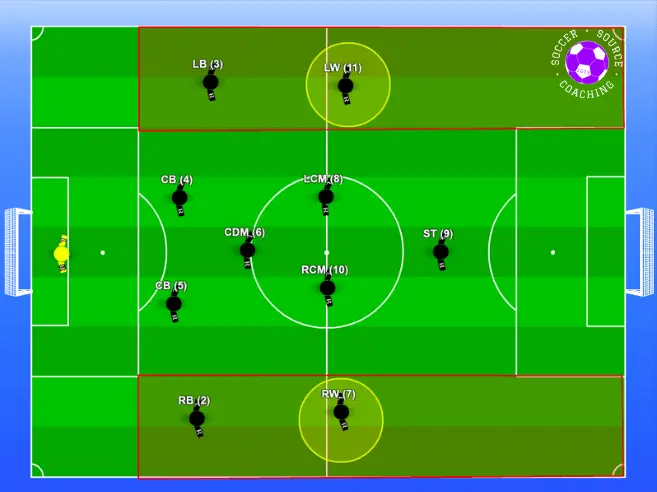
The wingers play on the outside of the midfield 4, in the 4-1-4-1 soccer formation, you will have a left winger and a right winger.
Depending on the team’s tactics, some coaches may play with inverted wingers.
This means that a left-footed player will play on the right wing and a right-footed player will play on the left wing.
The main responsibility of the wingers is to create goal-scoring opportunities from wide areas, but they also have some defensive roles too!
Here is a complete guide on how to be a winger in soccer
Wingers’ roles and responsibilities when attacking
When the team has possession of the ball in their own half the winger should be looking to play as wide as possible and about 15 yards in front of the fullback.
This creates space in the middle for central players to receive the ball as well as giving the fullback and other teammates an option to play the wingers’ feet.
The positioning also allows for opportunities to spin and get in behind the fullback, if a quick attack looks likely to unfold.
When attacking in the opposition’s half it is crucial that they maintain that space to keep the opposition team stretched.
This will allow teammates or the winger to exploit the space with their dribbling, passing, or forward runs.
When the winger receives the ball they should look to deliver a cross into the box or take a shot on goal.
Wingers’ roles and responsibilities when defending
As well as playing a big role in team attacking tactics the winger also plays a significant role in helping the team defensively too.
When defending in the 4-1-4-1 soccer formation it is essential that the winger drop back to support their respective fullback.
Supporting and helping cover the fullback greatly reduces the opportunities oppositions teams can create from the wide.
The fullback should be communicating throughout the game when they are defending to ensure they are both on the same page, so they can successfully defend as a pair.
The striker’s responsibilities in a 4-1-4-1
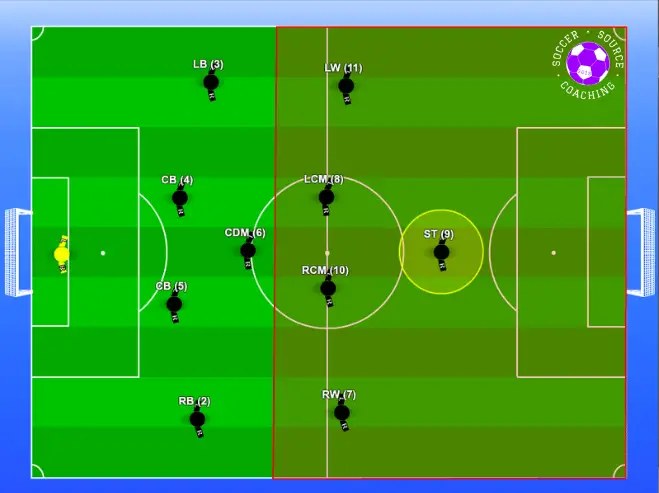
In the 4-1-4-1 soccer formation, it is the strikers’ responsibility to help the team score goals, whether it be scoring goals for themselves or providing assists for teammates.
Playing as lone a striker means that they are going to have to be a lot smarter with their movements and positioning as they will not always have the immediate support of their teammates.
Here is a complete guide on how to play as a striker in soccer
Strikers’ roles and responsibilities when attacking
In this formation, the striker will play more of a target player role that will look to hold the ball and bring other teammates into play.
When the team has possession of the ball in their defensive half, the striker should look to try and stay as high as possible in the central areas of the pitch.
This will allow their teammates to play a long ball to immediately relieve pressure.
It will allow the team to then build out an attack providing the striker has successfully held up the ball.
However, when the ball is in the attacking half the striker should be looking to occupy space between the two center backs or the fullbacks and center backs.
Playing in the opposition’s blind spots will make the strikers’ runs a lot harder to pick up, allowing them to get into better scoring positions.
Strikers’ roles and responsibilities when defending
The forwards are the team’s first line of defenders.
In this formation, the main role of the striker is to press and close off the passing lanes of the opposition defenders.
The striker must look for pressing triggers to fully take advantage of the press.
However, they must be smart with their pressing as it can be very physically draining.
The striker will also benefit the team by helping defend set pieces such as corners and freekicks.
Passing patterns for the 4-1-4-1 soccer formation
Which each soccer formation there are a variety of ways that teams can combine passes to create goal-scoring opportunities.
These are 5, 4-1-4-1 soccer formations, passing patterns of play that you can use in this formation.
4-1-4-1 Passing pattern for overloading the central area
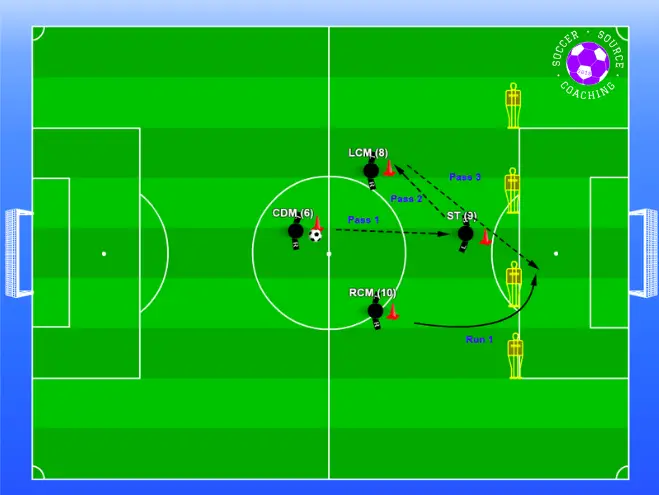
The purpose of this 4-1-4-1 passing pattern is to create an overload in the central area, with the right center midfielder being played through on goal.
The center defensive midfielder, striker, and left center midfielder will combine passes while the right center midfielder makes a third man in behind the defense.
4-1-4-1 Passing pattern for an overlapping fullback run
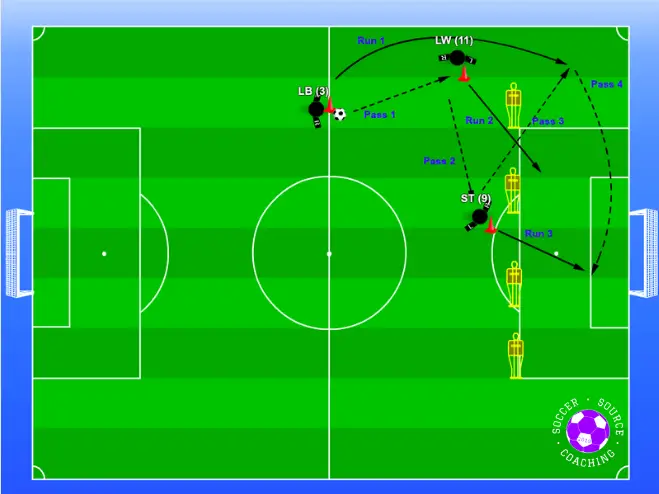
The purpose of this 4-1-4-1 passing pattern is to get the ball out wide to the fullback who has made an overlapping run.
The left-back will start with the ball and combine passes with the winger and striker, with the fullback carrying on their run beyond the winger to receive it from the striker.
This is where the fullback will cross the ball for the striker to score
4-1-4-1 Passing pattern for a third-man run
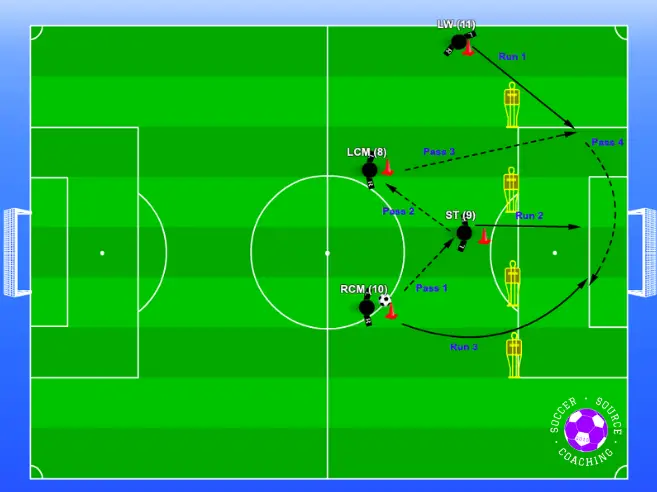
The purpose of this 4-1-4-1 passing pattern is to create and overload in a central area, while getting the ball out wide to deliver the cross.
This passing pattern involves the 2 central midfielders combing passes with the striker to get the ball out wide to the winger.
One of the central midfielders will run into the box with the striker in anticipation of the cross.
4-1-4-1 Passing pattern for an overlapping decoy run
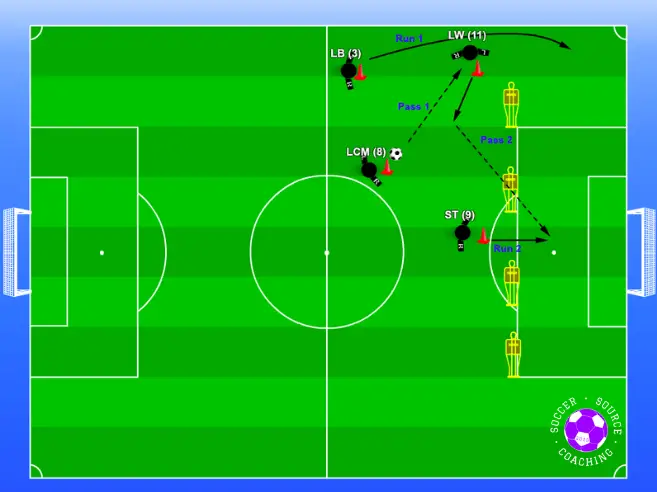
The purpose of this 4-1-4-1 passing pattern is to create a crossing opportunity using a decoy run of the fullback.
The ball will start with the central midfielder and pass the ball to the winger while the fullback is making an overlapping round them.
Instead of passing to the fullback the winger will cut in side and cross to the striker.
4-1-4-1 Passing pattern for an underlapping run
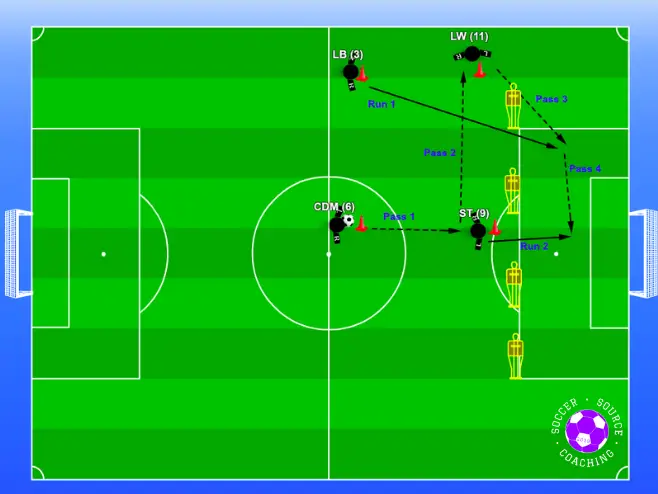
The purpose of this 4-1-4-1 passing pattern is to create an overload in a wide area using an underlapping run.
The CDM will combine passes with the striker and winger, with the winger playing a ball through to the fullback who has started their run from their position and receiving the ball between the opposition fullback and center back.
Which teams use the 4-1-4-1 soccer formation?
Leeds United was a team that would often use the 4-1-4-1 soccer formation under their former manager Bielsa.
They saw great success with this soccer formation as this is what they were using to get promoted to the English Premier League
Is the 4-1-4-1 a good soccer formation? The verdict
Yes, the 4-1-4-1 is a good soccer formation if:
- You are trying to see out a game to secure a win or a draw
- Your team that is comfortable defending for long periods of the game
- You are playing against an opponent who likes to keep possession and attack
- Your team is new to 11v11 and is trying to get to grips the with positions and tactics.
However, if you are a more attacking team then this may not be the formation for you.
If you don’t this formation would be a good fit for your team, here are some other options:
- 4-4-2 soccer formation
- 4-3-3 soccer formation
- The 4-2-3-1 soccer formation
- The 4-5-1 soccer formation
- 3-4-3 soccer formation
If you are unsure here is a summary of the best soccer formations for every play style
Remember to take into consideration the strengths and weaknesses of the 4-1-4-1 soccer formation as well as the players in your team!
I hope this post was able to help you better understand the 4-1-4-1 soccer formation.
You may also find this guide on youth soccer positions helpful too!
If you found this helpful or know another coach that would please share it with them using our social media buttons.
Thank you for sharing and reading,
Toby
